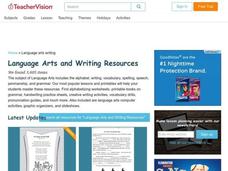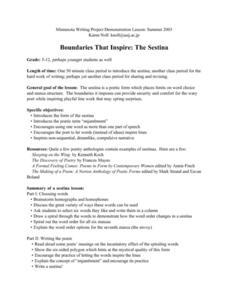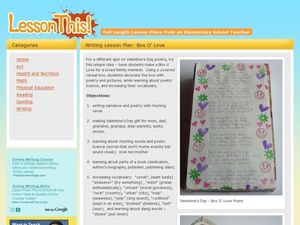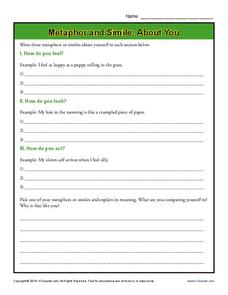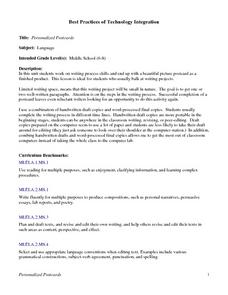Curated OER
Unit Plan for Mark Twain and American Humor
Students create brochures about the humor of Mark Twain. In this literature-analysis lesson plan, students read "The Celebrated Jumping Frog of Calaveras County" and other short stories by Twain. Students write analytical paragraphs and...
Curated OER
Harlem Renaissance
Students investigate the African American culture in the 1920's and the Harlem Renaissance. They read and analyze poems written by poets of the Harlem Renaissance, listen to jazz music and identify the characteristics of the music, and...
Curated OER
Transforming Fairy Tales
Students use the computer to write, draw, explore the Internet, and combine all of these elements. They write their own fairy tales, use computer software to create drawings of the characters for their tales and use the Internet to...
Curated OER
Jane Goodall, Renowned Naturalist and Champion of Chimpanzees
Students study the life of Jane Goodall and how she made an impact studying chimpanzees. In this endangered species lesson plan students write in their journals.
Curated OER
Buzz Up My Hive
Students research bees. In this organisms lesson, students participate in various learning centers to find out more about bees. The centers include watching a video and taking notes, reading books about bees, and going on a WebQuest. As...
Pennsylvania Department of Education
Analyzing Literary Elements in Fiction
Students analyze the characters and events in fictional writing. In this literary elements lesson, students study the meaning of the words characterization and fiction. They listen to the story Pigsty by Mark Teague, or any other book...
Curated OER
Football: It's Not Just for Jocks!
Eighth graders complete a variety of football-themed activities. They develop creative writing projects with a football inspiration, research and interpret football statistics and practice football skills in P.E.
Curated OER
I Know Why the Caged Bird Sings
Students read and analyze the novel "I Know Why the Caged Bird Sings" by Maya Angelou. They discuss the poetry and prose of the book, the importance of role models, complete a worksheet, and write a narrative using figurative language.
Curated OER
Boundaries That Inspire: The Sestina
Young scholars study the poetic term "enjambment". They use one word as more than one part of speech and let words (instead of ideas) inspire lines and non-sequential, dreamlike, compulsive narrative.
Curated OER
Box O' Love
Students create a Valentines Day poem using an empty cereal box as their canvas. In this poetry lesson, students create their poems using rhyming words and create sentences.
Tayasui.com
Drawing with Carl
Who is Carl? Carl is a little monster that will help your learners draw and create in any way imaginable. Get those kids to activate creative and imaginative thinking skills with a really fun app. There are endless options that can...
K12 Reader
Metaphor and Simile: About You
Class members will be as confident as prize-winning thoroughbreds after completing a worksheet on figurative language. Young writers jot down metaphors and similes for three categories: they way they look, they way they feel, and the way...
Curated OER
The Metamorphosis: Herber Readiness Activity
Delve into Franz Kafka's The Metamorphosis before opening the book with a lesson on literary themes. High schoolers engage in a word association activity before reading a list of statements based on the book's themes. Then, in groups,...
Curated OER
Theology…the Use of Silence in the Classroom
Immerse your class in the Middle Ages with a thorough history lesson. After viewing examples of illuminated manuscripts such as the Book of Kells, they discuss how these were the mode of keeping and storing information employed by the...
Curated OER
Bums in the Attic
Students engage in a study about the life of young girl in the book "Bums In The Attic". They read the narrative story while considering the first person point of view. Students write a journal that analyzes the author's style of writing.
Curated OER
Stain My Days Blue
Students read several poems related to the life and culture of the Appalachia region. They are introduced to the poetic forms of simile, alliteration and onomatopoeia and respond to the poems through journal entries and poetry of their own.
Curated OER
Personalized Postcards
Students create and send postcards to friends and family members. Using actual photographs, they write a rough draft and final draft of a paragraph and print it out to glue onto a postcard template to mail to their friend or family member.
Curated OER
Am I Really Free?
Fourth graders write about slavery and freedom. In this freed slaves lesson, 4th graders read historical information about free blacks during slavery and explore books, objects and slave narratives to learn more. Students write a...
Curated OER
Creative Writing Inspired by Paintings
Third graders view a PowerPoint presentation of the images by Maxfield Parrish. They wirte a short story based on one image and create drawings of an imagined character.
Curated OER
Comparison Contrast Essay
Students compare and contrast the experience of the migrant worker as depicted in The Grapes of Wrath with the experiences of migrant children as depicted in the narratives and poems provided.
Curated OER
Deciphering Community
Young scholars explore the concept of a community. They identify and group various kinds of communities. Students create a concept map exemplifying their membership in different communities. They write a narrative describing their...
Curated OER
Animal and People Habitats
Students examine how animals create a unique space in which they can live. Students read a poem about animals' habitats discuss the habitats. They draw a space of their own and write a poem that describes their habitat.
Curated OER
Language Arts: Lewin Project
Fourth graders read and respond to the poem, "When I Am Angry." They complete surveys by analyzing the most common feeling and draw a bar graph of their behavior, using different colors to identify the duration of various feelings. ...
Curated OER
Reader's Theater
Students act out and interpret the story for their peers. They study the simplest form of an organized reading to a more elaborate activity involving props, costumes, or a reinterpretation of the narrative into another art form.









